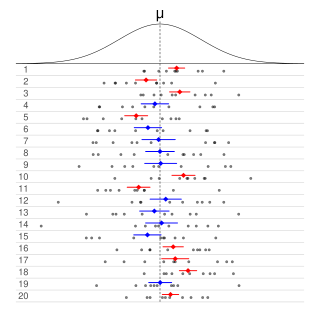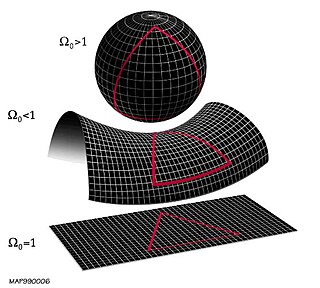The anthropic principle, also known as the observation selection effect, is the hypothesis that the range of possible observations that could be made about the universe is limited by the fact that observations are only possible in the type of universe that is capable of developing intelligent life. Proponents of the anthropic principle argue that it explains why the universe has the age and the fundamental physical constants necessary to accommodate intelligent life. If either had been significantly different, no one would have been around to make observations. Anthropic reasoning has been used to address the question as to why certain measured physical constants take the values that they do, rather than some other arbitrary values, and to explain a perception that the universe appears to be finely tuned for the existence of life.

In physical cosmology, the Copernican principle states that humans are not privileged observers of the universe, that observations from the Earth are representative of observations from the average position in the universe. Named for Copernican heliocentrism, it is a working assumption that arises from a modified cosmological extension of Copernicus' argument of a moving Earth.

The Drake equation is a probabilistic argument used to estimate the number of active, communicative extraterrestrial civilizations in the Milky Way Galaxy.

The Fermi paradox is the discrepancy between the lack of conclusive evidence of advanced extraterrestrial life and the apparently high likelihood of its existence. Those affirming the paradox generally conclude that if the conditions required for life to arise from non-living matter are as permissive as the available evidence on Earth indicates, then extraterrestrial life would be sufficiently common such that it would be implausible for it not to have been detected yet.
In statistics, interval estimation is the use of sample data to estimate an interval of possible values of a parameter of interest. This is in contrast to point estimation, which gives a single value.

Informally, in frequentist statistics, a confidence interval (CI) is an interval which is expected to typically contain the parameter being estimated. More specifically, given a confidence level , a CI is a random interval which contains the parameter being estimated % of the time. The confidence level, degree of confidence or confidence coefficient represents the long-run proportion of CIs that theoretically contain the true value of the parameter; this is tantamount to the nominal coverage probability. For example, out of all intervals computed at the 95% level, 95% of them should contain the parameter's true value.
Frank Jennings Tipler is an American mathematical physicist and cosmologist, holding a joint appointment in the Departments of Mathematics and Physics at Tulane University. Tipler has written books and papers on the Omega Point based on Pierre Teilhard de Chardin's religious ideas, which he claims is a mechanism for the resurrection of the dead. He is also known for his theories on the Tipler cylinder time machine. His work has attracted criticism, most notably from Quaker and systems theorist George Ellis, who has argued that his theories are largely pseudoscience.
In statistical inference, specifically predictive inference, a prediction interval is an estimate of an interval in which a future observation will fall, with a certain probability, given what has already been observed. Prediction intervals are often used in regression analysis.

The fine-tuned universe is the hypothesis that, because "life as we know it" could not exist if the constants of nature – such as the electron charge, the gravitational constant and others – had been even slightly different, the universe is tuned specifically for life. In practice, this hypothesis is formulated in terms of dimensionless physical constants.

The doomsday argument (DA), or Carter catastrophe, is a probabilistic argument that claims to predict the future population of the human species based on an estimation of the number of humans born to date. The doomsday argument was originally proposed by the astrophysicist Brandon Carter in 1983, leading to the initial name of the Carter catastrophe. The argument was subsequently championed by the philosopher John A. Leslie and has since been independently conceived by J. Richard Gott and Holger Bech Nielsen. Similar principles of eschatology were proposed earlier by Heinz von Foerster, among others. A more general form was given earlier in the Lindy effect, which proposes that for certain phenomena, the future life expectancy is proportional to the current age and is based on a decreasing mortality rate over time.

In planetary astronomy and astrobiology, the Rare Earth hypothesis argues that the origin of life and the evolution of biological complexity, such as sexually reproducing, multicellular organisms on Earth, and subsequently human intelligence, required an improbable combination of astrophysical and geological events and circumstances. According to the hypothesis, complex extraterrestrial life is an improbable phenomenon and likely to be rare throughout the universe as a whole. The term "Rare Earth" originates from Rare Earth: Why Complex Life Is Uncommon in the Universe (2000), a book by Peter Ward, a geologist and paleontologist, and Donald E. Brownlee, an astronomer and astrobiologist, both faculty members at the University of Washington.

The flatness problem is a cosmological fine-tuning problem within the Big Bang model of the universe. Such problems arise from the observation that some of the initial conditions of the universe appear to be fine-tuned to very 'special' values, and that small deviations from these values would have extreme effects on the appearance of the universe at the current time.
The Great Filter is the idea that, in the development of life from the earliest stages of abiogenesis to reaching the highest levels of development on the Kardashev scale, there is a barrier to development that makes detectable extraterrestrial life exceedingly rare. The Great Filter is one possible resolution of the Fermi paradox.
The self-indication assumption doomsday argument rebuttal is an objection to the doomsday argument by arguing that the chance of being born is not one, but is an increasing function of the number of people who will be born.
In string theory, the string theory landscape is the collection of possible false vacua, together comprising a collective "landscape" of choices of parameters governing compactifications.
The Ultimate Boeing 747 gambit is a counter-argument to modern versions of the argument from design for the existence of God. It was introduced by Richard Dawkins in chapter 4 of his 2006 book The God Delusion, "Why there almost certainly is no God".

The Boltzmann brain thought experiment suggests that it might be more likely for a brain to spontaneously form in space, complete with a memory of having existed in our universe, rather than for the entire universe to come about in the manner cosmologists think it actually did. Physicists use the Boltzmann brain thought experiment as a reductio ad absurdum argument for evaluating competing scientific theories.

Neocatastrophism is the hypothesis that life-exterminating events such as gamma-ray bursts have acted as a galactic regulation mechanism in the Milky Way upon the emergence of complex life in its habitable zone. It is one of several proposed solutions to the Fermi paradox since it provides a mechanism which would have delayed the advent of intelligent beings in local galaxies near Earth.
Sebastian Rudolf Karl von Hoerner was a German astrophysicist and radio astronomer.
Exact statistics, such as that described in exact test, is a branch of statistics that was developed to provide more accurate results pertaining to statistical testing and interval estimation by eliminating procedures based on asymptotic and approximate statistical methods. The main characteristic of exact methods is that statistical tests and confidence intervals are based on exact probability statements that are valid for any sample size. Exact statistical methods help avoid some of the unreasonable assumptions of traditional statistical methods, such as the assumption of equal variances in classical ANOVA. They also allow exact inference on variance components of mixed models.










